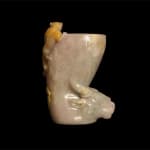Jade Rhyton, 20th Century CE
Jade
5
SP.612
Further images
An ornamental stone, jade is applied to two different rocks that are made up of different silicate minerals. Nephrite jade consists of the calcium- and magnesium-rich amphibole mineral actinolite (aggregates...
An ornamental stone, jade is applied to two different rocks that are made up of different silicate minerals. Nephrite jade consists of the calcium- and magnesium-rich amphibole mineral actinolite (aggregates of which also make up one form of asbestos). The rock called jadeitite consists almost entirely of jadeite, a sodium- and aluminium-rich pyroxene. The English word 'jade' is derived from the Spanish term piedra de ijada (first recorded in 1565) or 'loin stone', from its reputed efficacy in curing ailments of the loins and kidneys. 'Nephrite' is derived from lapis nephriticus, the Latin version of the Spanish piedra de ijada.[1] Because both were used by Stone and Bronze Age cultures for similar purposes, and they are both about as hard as quartz, exceptionally tough, beautifully coloured and can be delicately shaped, it was not until the 19th century that a French mineralogist determined that "jade" was in fact two different materials. During the Stone Age of many cultures, jade was used for axe heads, knives, and other weapons. As metal-working technologies became available, jade's beauty made it valuable for ornaments and decorative objects. Jade has a Mohs hardness of between 6.5 and 7.0 [1], so it can be worked with quartz or garnet sand, and polished with bamboo or even ground jade. Nephrite can be found in a creamy white form (known in China as "mutton fat" jade) as well as in a variety of green colours, whereas jadeitite shows more colour variations, including dazzling blue, lavender-mauve, pink and emerald-green colours. Of the two, jadeitite is rarer, documented in less than 12 places worldwide. Translucent emerald-green jadeitite is the most prized variety, both now and historically. As "quetzal" jade, bright green jadeitite from Guatemala was treasured by Mesoamerican cultures, and as "kingfisher" jade, vivid green rocks from Burma became the preferred stone of post-1800 Chinese imperial scholars and rulers. Burma (Myanmar) and Guatemala are the principal sources of modern gem jadeitite, and Canada of modern lapidary nephrite. Nephrite jade was used mostly in pre-1800 China as well as in New Zealand, the Pacific Coast and Atlantic Coasts of North America, Neolithic Europe, and southeast Asia. In addition to Mesoamerica, jadeitite was used by Neolithic Japanese and European cultures.





